Understanding the “State of Crypto Index”

Summary: I talk about the mental game of investing, particularly as it applies to crypto markets. Subscribe here and follow me to get weekly updates.
Here’s a tool that will give you new reasons to invest in crypto.
And it’s not based on price, it’s based on real-life users.
It’s the new State of Crypto Index, by the storied venture capital firm Andreessen Horowitz (also called “a16z”), which has invested billions into crypto startups since 2013.
Below I’ll explain how this tool works. But first, here’s why it’s so important for crypto investors.
Users are the “Demand”
Crypto must be used to be useful.
You can measure the price of bitcoin all day long, but measuring the users of bitcoin is a much more valuable metric. (Hint: bitcoin users have stayed about the same since 2020.)
After all, crypto companies are meant to connect people, to help them transact with new forms of value. If the price is going up but the number of users is going down, that doesn’t say much about its usefulness.
(To the contrary, if the price is going down but the number of users is going up, that could signal a great bargain.)
It seems so obvious that we shouldn’t have to say it: crypto must be used to be useful. But almost nobody invests this way. Everyone gets excited about price growth; rarely do people get excited about user growth.
User growth is one of our core investing principles: we measure it every Thursday in our Top 10 Fundamentals newsletter for Premium members. If long-term users are growing, then long-term prices will usually grow like a weed.
Measuring Users with the State of Crypto Index
Like any index, the State of Crypto Index is meant to give us a high-level snapshot of the industry over time: is it growing or shrinking?
In a16z lingo, users are what they call “demand.” (The more crypto users, the more demand for crypto products.)
They roll up a bunch of user metrics into a single chart on the bottom right:

To the right of the chart, you can see the metrics that go into this chart (like ingredients that go into a recipe):
- Active addresses: the number of unique users across top blockchains
- Transaction: the number of unique transactions across top blockchains
- Transaction fees: the amount that people are paying to use top blockchains (e.g., gas fees on Ethereum)
- Mobile wallet users: the number of unique users on top crypto mobile wallets
- DEX volume: the value of tokens exchanged across top decentralized exchanges (e.g., Uniswap)
- NFT buyers: the number of unique users buying NFTs
- Stablecoin volume: The value of stablecoins transferred across top blockchains
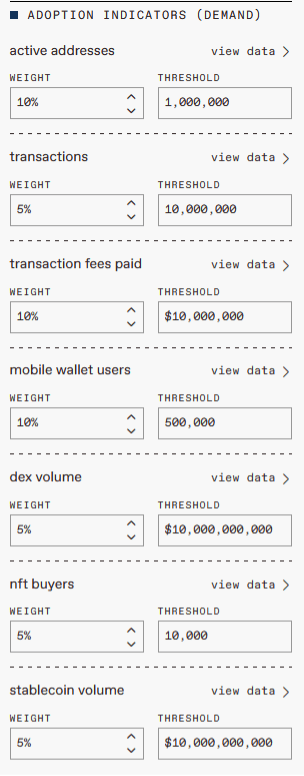
What I love about this index is that you can change the weighting of the ingredients to adjust the recipe. For example, I would weight active addresses much more heavily, while I would de-emphasize transaction fees (because they are dependent on price):
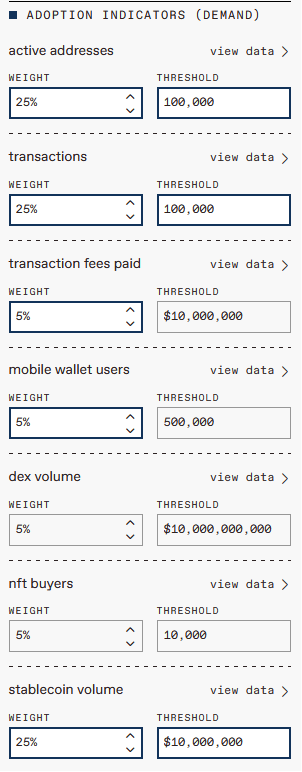
Producing a chart that looks more like this:

The important thing is not the weighting, but the overall shape of the chart as you play with the weightings. Is it still moving in the direction of growth? If so, the industry is very likely growing.
But the index does more than measure user growth across the industry. It also measures developer growth.
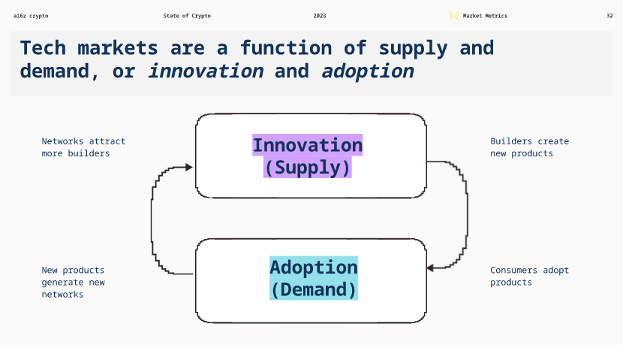
Developers are the “Supply”
If users provide the demand for crypto products, developers provide the supply. (With price attracting both.)
Take bitcoin: as more people started to buy it, that drove up the price, which got more developers interested in building crypto tokens and projects. This drove higher prices, more users, and so on. Virtuous circle.
Of course, this never happens in a linear fashion, but in waves. Take this excellent slide that shows when famous tech firms started vs. the overall stock market:

The long-term trajectory is one of upward growth, with many of today’s most powerful companies started during market downturns.
The question mark at the far right of the slide means, What world-changing crypto company is being built right now?
Developers and users. Supply and demand. It’s like the old question about the chicken and the egg: which came first?
As investors, it doesn’t really matter, as long as we’re measuring both.
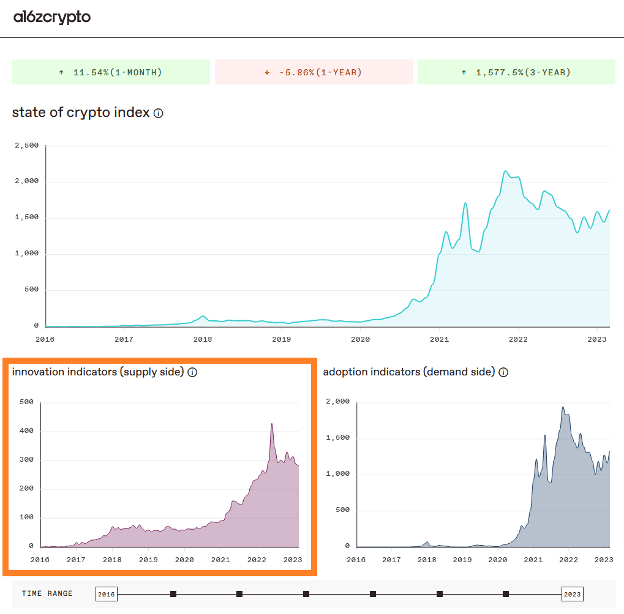
Measuring Developers with the State of Crypto Index
To measure developers (or the supply side), the ingredients are:
- Active developers: the number of developers building crypto projects (e.g., through Github)
- Interested developers: the number of developers playing around with it
- Contract deployers: The number of devs deploying new code on public blockchains
- Verified smart contracts: The number of new applications launched
- Developer library downloads: The number of downloads of apps to help developers
- Academic publications: The number of published research papers around crypto topics
- Job search interest: The number of searches on blockchain- and crypto-related jobs

Just as I see active users as the primary metric for crypto adoption, active developers is the primary metric on crypto development. So my recipe would place way more emphasis on active developers, something like this:
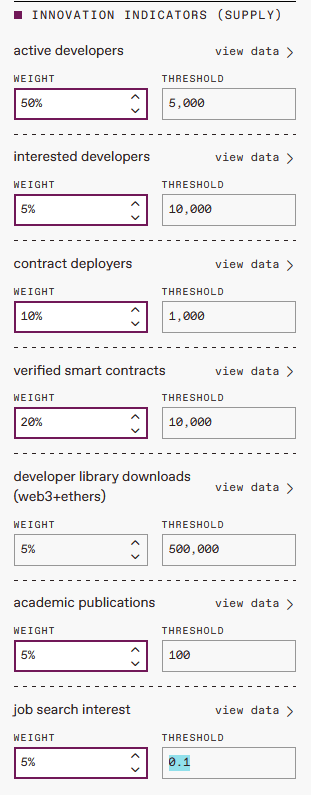
Creating a chart that is still similar to the defaults provided by a16z:

With my improved recipe, the overall index looks even better than a16z’s outlook:
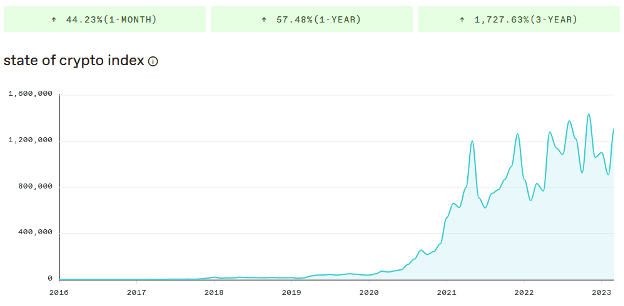
It is a picture of astounding long-term growth. As a point of reference, if you invested $1 that grew into $1727 in three years, you would be considered an investing genius. That’s what investing in this overall industry has been like.
And the long-term results have been even better.
(Still, be cautious of the roller-coaster ups and downs of the crypto market. Our Blockchain Believers Portfolio will keep you well-diversified.)
Why Not Just Measure Price?
No matter how you tweak this index, chances are you’ll still get something that looks a lot like the price of the crypto market. Or to put it even more crudely, a chart that looks like the price of bitcoin:
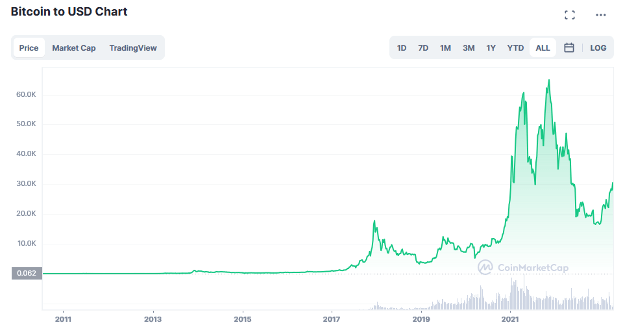
Again, price can be deceptive. It’s one data point, and it’s fueled by fear and greed. This index is a powerful tool because it incorporates many data points that show the growth of the underlying infrastructure – both supply and demand.
Investor Takeaway: Apply This to Individual Tokens
As investors, we’re after the hidden gems, the undervalued crypto tokens. We can use this same methodology to drill into individual crypto projects, to look at their overall demand (users) and supply (developers).
To do this, we have a great tutorial on How to Read Crypto Financial Statements. Using companion reports from Token Terminal, we’ll show you how to find both active developers and active users (supply and demand) for all the leading crypto tokens.
Think of a16z’s State of Crypto Index as rolling all this info into one helpful chart, to show us how the industry is growing as a whole.
Remember: it’s never a straight shot. That’s not how growth happens. Instead, it’s a rolling series of ups and downs, that gradually lead us to more users, more developers, and more long-term wealth.
Investing in that long-term future is what we’re here to do. Now, with the State of Crypto Index, we have a new way to measure our progress.






 Bitcoin
Bitcoin  Ethereum
Ethereum  Tether
Tether  USDC
USDC  TRON
TRON  Dogecoin
Dogecoin  Cardano
Cardano  Chainlink
Chainlink  Bitcoin Cash
Bitcoin Cash  Stellar
Stellar  Zcash
Zcash  LEO Token
LEO Token  Hedera
Hedera  Litecoin
Litecoin  Monero
Monero  Cronos
Cronos  Dai
Dai  OKB
OKB  Ethereum Classic
Ethereum Classic  Tether Gold
Tether Gold  KuCoin
KuCoin  Algorand
Algorand  VeChain
VeChain  Cosmos Hub
Cosmos Hub  Gate
Gate  Dash
Dash  Stacks
Stacks  Tezos
Tezos  IOTA
IOTA  Decred
Decred  TrueUSD
TrueUSD  Theta Network
Theta Network  NEO
NEO  Basic Attention
Basic Attention  Synthetix
Synthetix  Qtum
Qtum  0x Protocol
0x Protocol  DigiByte
DigiByte  Ravencoin
Ravencoin  Nano
Nano  Zilliqa
Zilliqa  Holo
Holo  Siacoin
Siacoin  Numeraire
Numeraire  Enjin Coin
Enjin Coin  Ontology
Ontology  Waves
Waves  Status
Status  Hive
Hive  Pax Dollar
Pax Dollar  BUSD
BUSD  Lisk
Lisk  Steem
Steem  Huobi
Huobi  OMG Network
OMG Network  Bitcoin Gold
Bitcoin Gold  Augur
Augur  NEM
NEM  Ren
Ren